Table of Contents
THE MOON FOR ASTRONOMERS
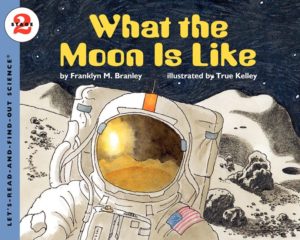
|
Franklyn M. Branley’s What the Moon is Like (HarperCollins, 2000) in the Let’s-Read-and-Find-Out science series is a simple reader-friendly introduction to the moon, illustrated with drawings and photographs. Included is a short list of activities, among them instructions for making a moon crater (you’ll need flour, cocoa powder, and a marble), designing a space colony, and calculating your weight on the moon. For ages 4-8. |
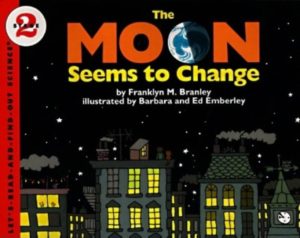
|
In the same series, Branley’s The Moon Seems to Change (HarperCollins, 1987) is a simple explanation of moon phases for ages 4-9, illustrated with appealing diagrams. Included is a try-it-yourself demo using an orange and a flashlight. |
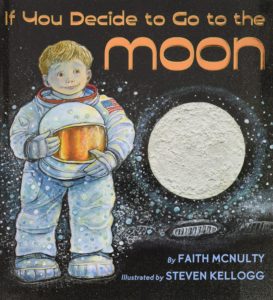
|
Faith McNulty’s If You Decide to Go to the Moon (Scholastic Press, 2005) is a conversational travel manual for potential lunar astronauts, written in the style of How to Dig a Hole to the Other Side of the World (1979), with illustrations by Steven Kellogg. A little boy sets off for the moon in his own rocket ship (“Check the things you will need: space suit, air tanks, books, and games.”), shooting through space to land in the Sea of Tranquility. Moon facts are tucked into the narrative; and a pair of fold-out spreads emphasizes the differences between the empty landscape of the moon and the lush life-packed landscape of Earth. For ages 4-9. |
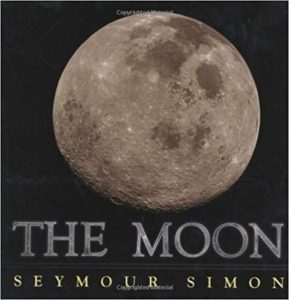
|
Seymour Simon’s The Moon (Simon & Schuster Books for Young Readers, 2003), illustrated with gorgeous color photographs, is an excellent nonfiction introduction for ages 6-11. |
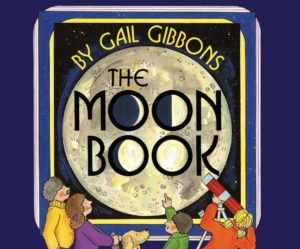
|
Gail Gibbons’s The Moon Book (Holiday House, 1997), illustrated with diagrams and bright paintings, covers how the moon shines, moon phases, eclipses, lunar exploration, and moon lore and legends. Included are instructions for making a simple pinhole solar eclipse viewer. For ages 7-11. |
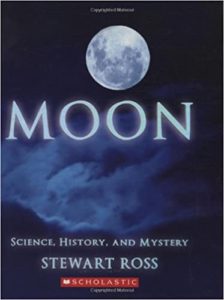
|
Stewart Ross’s Moon: Science, History, and Mystery (Scholastic, 2009) covers everything from moon gods and moon lore to Isaac Newton and the Apollo missions in 128 cleverly designed pages packed with photographs, art reproductions, cool moon facts, and interesting information. An excellent overview for ages 9-12. |
| From Mensa for Kids, The Moon is an early-elementary-level lesson plan, including a crater art project, a printable to-be-filled-out moon phases calendar, and an online moon phase matching game. | |
| From Enchanted Learning, The Moon has basic information, labeled illustrations, and printable activities, among these a moon phases diagram, a fill-in-the-blank lunar calendar, moon quizzes, and a pattern for a moon mobile made from an aluminum pie plate. | |
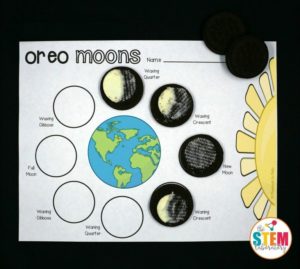 |
From Paper Plate Education, Oreo Moon Phases is an activity for early-elementary-level kid in which they demonstrate the moon cycle using Oreo cookies. |
| For a more detailed version of this activity (no Oreos) for older students, see Paper Plate’s Moon Finder. | |
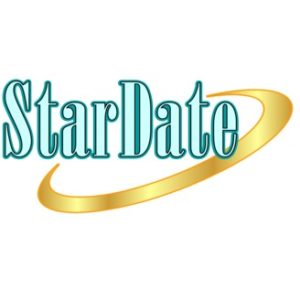 |
StarDate has an illustrated monthly calendar of moon phases and background information on the moon, including a diagram showing what causes moon phases, a list of Native American moon names, and an explanation of when the young moon first becomes visible in the evening sky (record for earliest observed crescent is just 19 hours). |
| The Lunar Phase Simulator is an animation showing the relative positions of sun, earth, and moon during the lunar cycle. |
|
| See this free printable Moon Journal for recording moon phases. | |
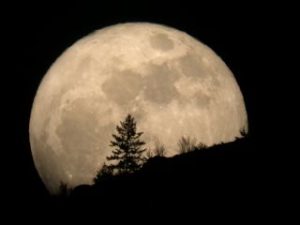 |
Why does the Moon sometimes look HUGE? It’s an illusion. Find out about it here. |
| Modeling the Earth-Moon System from NASA’s Jet Propulsion Laboratory. You’ll need a couple of balloons, a basketball or beach ball, and a tennis ball. | |
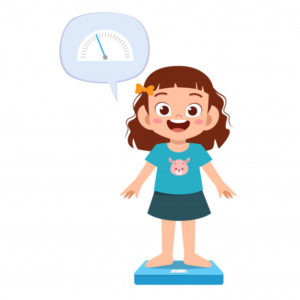 |
From the San Francisco Exploratorium, Your Weight on Other Worlds is an online calculator: fill in your Earth weight and discover what your weight would be on each of the planets and the moon. |
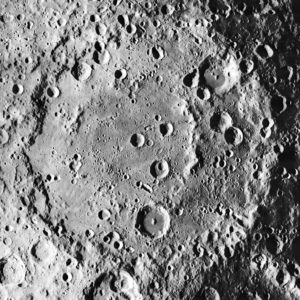 |
To the Moon is a collection of projects and activities aimed at ages 8-13, among them “Crater Creations,” “Build a Moon Base!” “The Scoop on Moon Dirt,” and “Moon Mission.” An activity that involves assessing information collected by the lunar missions. |
| NASA’s downloadable Exploring the Moon Educator Guide covers lunar science and exploration for grades 4-12 with fact sheets, detailed explanations, illustrations and diagrams, discussion questions, and activities. Sample unit titles are Learning from Apollo, Lunar Surface, Lunar Landing Sites, Impact Craters, and Lunar Biospheres. | |
| The Full Story on the Moon has illustrated reader-friendly explanations of moon origin theories, the man in the moon, moon phases, and tides. | |
| Middle School Science’s Moon has a creative collection of lesson plans, projects, demonstrations, and printable worksheets. In “Crash Landing,” for example, kids determine what kind of supplies they’d need if they crash-landed on the moon. (Water? Matches?) Other activities involve making a moon clock using a printable template, determining the diameter of the moon, and exploring lunar phases and eclipses. | |
| The Lunar and Planetary Institute’s Moon Flip Book has instructions for making a moon phases flip book from black-and-white moon photographs (print, cut out, and assemble). | |
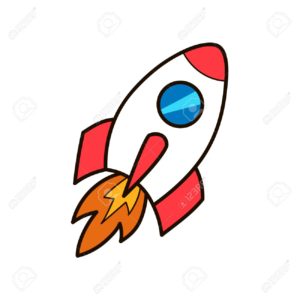 |
30 Minute Rocket has instructions for building an air-powered bottle rocket (in just 30 minutes), using a plastic soda bottle, two sizes of drinking straws, and clay. |
